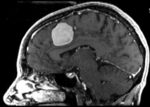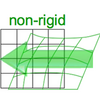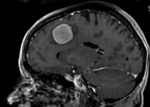Documentation:Nightly:Registration:RegistrationLibrary:RegLib C01
From Slicer Wiki
Revision as of 19:07, 19 August 2013 by Meier (talk | contribs) (Created page with 'Back to Registration Library <br> = Slicer Registration Library Case #1: Follow-up MRI of Brain Tumor = == Input == {|…')
Home < Documentation:Nightly:Registration:RegistrationLibrary:RegLib C01
Contents
Slicer Registration Library Case #1: Follow-up MRI of Brain Tumor
Input
| fixed image | moving image |
Objective / Background
Goal is to align the follow-up image with the reference/baseline scan to assess changes.
Modules used
Download (from NAMIC MIDAS)
Keywords
MRI, brain, head, intra-subject, meningioma
Video Screencasts
Procedure
- Rigid Registration: open the General Registration (BRAINS) module
- Input Images: Fixed Image Volume: MRMeningioma_1
- 'Input Images: Moving Image Volume: MRMeningioma_2
- Output Settings:
- Slicer Linear Transform (create new transform, rename to: "Xf1_Rigid")
- Output Image Volume none
- Registration Phases: select/check Rigid
- Initialization Phases: none
- Main Parameters:
- Leave all other settings at default
- click: Apply; runtime < 10 sec
- Affine registration: We have now increase the DOF to 12 in the form of an affine transform that also corrects scale and allows shear.
Registration Results
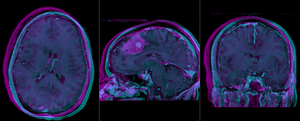 |
baseline and follow-up before registration (click to enlarge) |
| 300px | after rigid alignment. Note the residual shape differences (click to enlarge) |
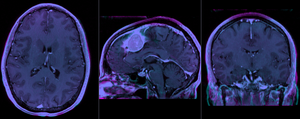 |
after affine registration (click to enlarge) |
Discussion: Key Strategies
- The affine registration seeks to address residual distortions that are typical for longitudinal MRI. However to prevent the tumor (and putative tumor change) from affecting the registration, we mask out the tumor so that it does not contribute to the registration. The assumption is thus that aside from the tumor we expect the two serial scans to be matching exactly, i.e. any differences in size or shape is considered an artifact we wish to remove by registration.
